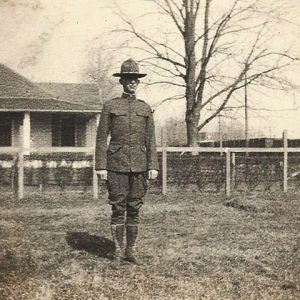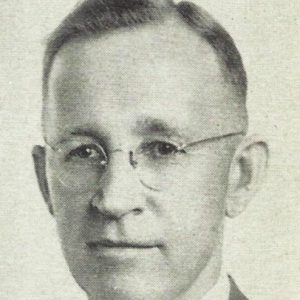calsfoundation@cals.org
James Harris (J. H.) Atkinson (1888–1973)
James Harris (J. H.) Atkinson was an educator, author, and historian who, through his leadership in state and local historical organizations, significantly advanced the preservation and awareness of Arkansas’s history, earning him the nickname “Mr. Arkansas History.” He helped organize and subsequently served as president of both the Arkansas Historical Association (AHA) and the Pulaski County Historical Society (PCHS), wrote numerous articles for each of their publications, served as chairman of the Arkansas History Commission (now called the Arkansas State Archives), and co-authored Historic Arkansas, a text for teaching Arkansas history.
J. H. Atkinson was born on June 7, 1888, in a farmhouse near the community of College Hill in northern Columbia County, the son of Gracie Ella Finley and Samuel Washington Atkinson. He grew up with two younger sisters and attended the one-room schools near his home. Determined to go to college, Atkinson struggled to find high school courses in his rural area that would adequately prepare him. He finished high school at a Baptist-run academy in Bodcaw (Nevada County) in 1906 and, that fall, entered the University of Arkansas (UA) in Fayetteville (Washington County). Atkinson earned his BA degree in 1910.
Atkinson began teaching full time in the fall of 1910, first in Nashville (Howard County) and Foreman (Little River County), before moving to Little Rock (Pulaski County) in 1916 to teach history at Little Rock High School (later called Little Rock Central High School). After a five-month stint in the U.S. Army at the end of World War I, Atkinson returned to teaching in 1919 as superintendent of the rural district at Wilmot (Ashley County). In the summer of 1922, he took graduate education classes at Columbia University in New York City. In 1923, Atkinson returned to Little Rock High School as head of the history department and supervisor of the Adult Night School. He was also active in promoting a state retirement system for teachers (enacted in 1937). In 1927, he earned an MA in history from the University of Chicago, writing his thesis on the end of Reconstruction in Arkansas. After finishing his graduate studies, Atkinson aided in the formation of Little Rock Junior College (now the University of Arkansas at Little Rock) and was a member of its initial faculty. He taught history and chaired the Department of History and Economics until his retirement in 1957.
On July 28, 1920, Atkinson married Zora Lee Langston of Lee County, who also had a long career as a teacher. They had no children.
Having to teach his students about their native state, Atkinson recognized the dearth of materials on the state’s history. He wrote two texts on the subject: History of Arkansas in 1917 and Historic Arkansas with co-author John L. Ferguson in 1966. Atkinson worked with his former professor, noted Arkansas historian David Yancey Thomas, to reorganize a state historical society that had existed briefly around 1903. In early 1941, Thomas, with the help of Atkinson and others, formed the Arkansas Historical Association, which began publishing the Arkansas Historical Quarterly in 1942. Atkinson served on the Quarterly’s editorial board throughout the rest of his life, contributed a number of articles for publication, led the effort to hold annual association meetings beginning in 1946, and served as AHA president from 1952 to 1953.
In 1949, Governor Sid McMath appointed Atkinson to a twelve-year term on the Arkansas History Commission, where he served eight years as commission chairman. During his tenure, the AHC built a three-story annex to the Old State House, which housed the state’s growing archive, and started a microfilming project. Dr. John L. Ferguson, director of the AHC, credited Atkinson with having “revitalized and strengthened our archival program” and for being “directly responsible for many important additions to our collections.”
Believing that the history of local events was of most interest to people, Atkinson promoted the organization of county and local societies. He was one of the founders of the Pulaski County Historical Society in the fall of 1951 and played a key role in its formative years, serving two terms as president. When the first Pulaski County Historical Review editor resigned, Atkinson stepped in temporarily and continued as editor for fourteen years (1958–1971). He wrote many articles for the journal and three of the society’s five Bulletin Series publications. In 1971, the PCHS recognized Atkinson for his years of service by naming him president emeritus.
Atkinson died on September 17, 1973, while recuperating from surgery at St. Vincent Infirmary. He is buried at Roselawn Cemetery in Little Rock. In 1989, the AHA created the James H. Atkinson Award for Excellence in the Teaching of Arkansas History, presented annually to an outstanding teacher of Arkansas history.
For additional information:
Atkinson, James H. “How I Became a Teacher,” “The First School That I Taught,” “Preparing to Enter College in 1906,” and “Getting a Degree from the University of Arkansas in 1910.” Pulaski County Historical Review 19 (March 1971): 2–16.
———. “Memories of a University Student, 1906.” Arkansas Historical Quarterly 30 (Autumn 1971): 213–241.
———. “My Career as a Teacher.” Pulaski County Historical Review 17 (December 1969): 51–56.
———. “Our Society, A History.” Pulaski County Historical Review 21 (June 1973): 44–47; reprinted 49 (winter 2001): 89–91.
“Historian, Educator Dies at 85.” Arkansas Gazette, September 18, 1973, p.12B.
Park, Hugh. “James Harris Atkinson, 1888–1973.” Arkansas Historical Quarterly 32 (Winter 1973): 370–380.
Polston, Michael David. “‘Time Does Not Count Here’: Letters of an American Doughboy Stationed at Camp Pike.” Pulaski County Historical Review 33 (Winter 1985): 74–81.
Richter, Wendy. “Celebrating Fifty Years of the Arkansas Historical Association.” Arkansas Historical Quarterly 55 (Summer 1996): 167–172.
Martha Williamson Rimmer
Little Rock, Arkansas
 J. H. Atkinson
J. H. Atkinson  J. H. Atkinson
J. H. Atkinson 



Comments
No comments on this entry yet.